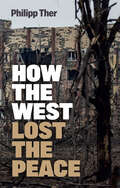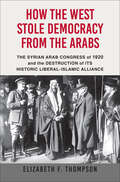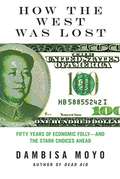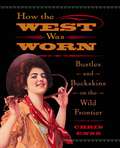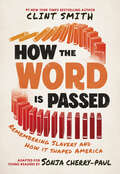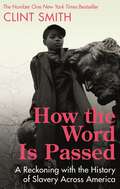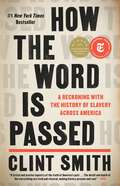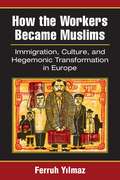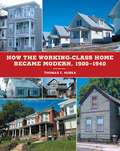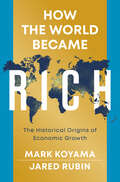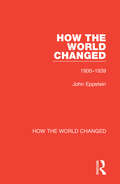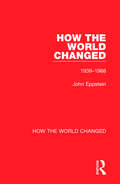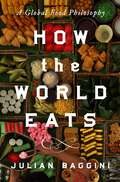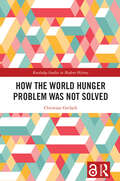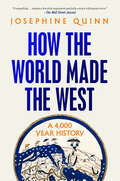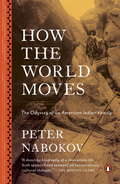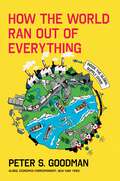- Table View
- List View
How the West Lost the Peace: The Great Transformation Since the Cold War
by Philipp TherWhen the Berlin Wall was stormed and the Soviet Union fell apart, the West and above all the United States looked like the sole victors of history. Three decades later, the spirit of triumph rings hollow. What went wrong? In this sequel to his award-winning history of neoliberal Europe, the renowned historian Philipp Ther searches for an answer to this question. He argues that global capitalism created many losers, preparing the ground for the rise of right-wing populists and nationalists. He shows how the promise of prosperity and freedom did not catch on sufficiently in Eastern Europe despite material progress, and how the West lost Russia and alienated Turkey. Neoliberal capitalism also left the world poorly prepared to cope with Covid-19, and the pandemic further weakened the Western hegemony of the post-1989 period, which is now brutally contested by Russia’s war against Ukraine. The double punch of the pandemic and the biggest war in Europe since 1945 has brought to a close the age of transformation that was inaugurated by the end of the Cold War. This penetrating analysis of the disarray of the post-1989 world will be of great interest to anyone who wishes to understand how we got to where we are today and the tremendous challenges we now face.
How the West Stole Democracy from the Arabs: The Syrian Arab Congress of 1920 and the Destruction of Its Historical Liberal-Islamic Alliance
by Elizabeth F. Thompson“This expertly researched account brings to life a meaningful but underexplored chapter in world history.” —Publishers WeeklyWhen Europe’s Great War engulfed the Ottoman Empire, Arab nationalists rose in revolt against the Turks. The British supported the Arabs’ fight for an independent state and sent an intelligence officer, T.E. Lawrence, to join Prince Faisal, leader of the Arab army and a descendant of the Prophet. In October 1918, Faisal, Lawrence, and the Arabs victoriously entered Damascus, where they declared a constitutional government in an independent Greater Syria.At the Paris Peace Conference, Faisal won the support of Woodrow Wilson, who sent an American commission to Syria to survey the political aspirations of its people. However, other Entente leaders at Paris—and later San Remo—schemed against the Arab democracy, which they saw as a threat to their colonial rule. On March 8, 1920, the Syrian-Arab Congress declared independence and crowned Faisal king of a “representative monarchy.” Rashid Rida, a leading Islamic thinker of the day, led the constituent assembly to establish equality for all citizens, including non-Muslims, under a full bill of rights.But France and Britain refused to recognize the Damascus government, instead imposing a system of mandates on the Arab provinces of the defeated Ottoman Empire, on the pretext that Arabs weren’t yet ready for self-government. Under such a mandate, the French invaded Syria in April, crushing the Arab government and sending Faisal and Congress leaders into exile. The fragile coalition of secular modernizers and Islamic reformers that might have established democracy in the Arab world was destroyed, with profound consequences that reverberate still.Using many previously untapped primary sources, including contemporary newspaper accounts and letters, minutes from the Syrian-Arab Congress, and diary and journal entries from participants, How The West Stole Democracy From The Arabs is a groundbreaking account of this extraordinary, brief moment of unity and hope—and of its destruction.“Important and fascinating.” —Amaney A. Jamal, Edwards S. Sanford Professor of Politics, Princeton University
How the West Was Drawn: Mapping, Indians, and the Construction of the Trans-Mississippi West (Borderlands and Transcultural Studies)
by David BernsteinHow the West Was Drawn explores the geographic and historical experiences of the Pawnees, the Iowas, and the Lakotas during the European and American contest for imperial control of the Great Plains during the eighteenth and nineteenth centuries. David Bernstein argues that the American West was a collaborative construction between Native peoples and Euro-American empires that developed cartographic processes and culturally specific maps, which in turn reflected encounter and conflict between settler states and indigenous peoples. Bernstein explores the cartographic creation of the Trans-Mississippi West through an interdisciplinary methodology in geography and history. He shows how the Pawnees and the Iowas—wedged between powerful Osages, Sioux, the horse- and captive-rich Comanche Empire, French fur traders, Spanish merchants, and American Indian agents and explorers—devised strategies of survivance and diplomacy to retain autonomy during this era. The Pawnees and the Iowas developed a strategy of cartographic resistance to predations by both Euro-American imperial powers and strong indigenous empires, navigating the volatile and rapidly changing world of the Great Plains by brokering their spatial and territorial knowledge either to stronger indigenous nations or to much weaker and conquerable American and European powers.How the West Was Drawn is a revisionist and interdisciplinary understanding of the global imperial contest for North America’s Great Plains that illuminates in fine detail the strategies of survival of the Pawnees, the Iowas, and the Lakotas amid accommodation to predatory Euro-American and Native empires.
How the West Was Lost: Fifty Years of Economic Folly---And the Stark Choices Ahead
by Dambisa MoyoDambisa Moyo offers a bold account of the decline of the economic supremacy of the West. She examines how the West's flawed financial decisions and blinkered political and military choices have resulted in an economic and geopolitical seesaw that is now poised to tip in favor of the emerging world.
How the West Was Won
by Louis L'AmourThey came by river and by wagon train, braving the endless distances of the Great Plains and the icy passes of the Sierra Nevada. They were men like Linus Rawlings, a restless survivor of Indian country who'd headed east to see the ocean but left his heart--and his home--in the West. They were women like Lilith Prescott, a smart, spirited beauty who fled her family and fell for a gambling man in the midst of a frontier gold boom. These pioneering men and women sowed the seeds of a nation with their courage--and with their blood. Here is the story of how their paths would meet amid the epic struggle against fierce enemies and nature's cruelty, to win for all time the rich and untamed West.From the Paperback edition.
How the West Was Won: A Novel (Louis L'Amour's Lost Treasures)
by Louis L'AmourAs part of the Louis L’Amour’s Lost Treasures series, this edition contains exclusive bonus materials!They came by river and by wagon train, braving the endless distances of the Great Plains and the icy passes of the Sierra Nevada. They were men like Linus Rawlings, a restless survivor of Indian country who’d headed east to see the ocean but left his heart—and his home—in the West. They were women like Lilith Prescott, a smart, spirited beauty who fled her family and fell for a gambling man in the midst of a frontier gold boom. These pioneering men and women sowed the seeds of a nation with their courage—and with their blood. Here is the story of how their paths would meet amid the epic struggle against fierce enemies and nature’s cruelty, to win for all time the rich and untamed West.Louis L’Amour’s Lost Treasures is a project created to release some of the author’s more unconventional manuscripts from the family archives. In Louis L’Amour’s Lost Treasures: Volumes 1, Beau L’Amour takes the reader on a guided tour through many of the finished and unfinished short stories, novels, and treatments that his father was never able to publish during his lifetime. L’Amour’s never-before-seen first novel, No Traveller Returns, will also be released as a Lost Treasures publication, followed by Louis L’Amour’s Lost Treasures: Volume 2. Additionally, many beloved classics such as Last of the Breed and Bendigo Shafter will be rereleased with an exclusive Lost Treasures postscript featuring previously unpublished material, including outlines, plot notes, and alternate drafts. These postscripts tell the story behind the stories that millions of readers have come to know and cherish.
How the West Was Worn: Bustles And Buckskins On The Wild Frontier
by Chris EnssFashion that was in vogue in the East was highly desirable to pioneers during the frontier period of the American West. It was also extraordinarily difficult to obtain, often impractical, and sometimes the clothing was just not durable enough for the men and women who were forging new homes for themselves in the West. Full hoopskirts were of little use in a soddy on the prairie, and chaps and spurs were a vital part of the cowboy's equipment.In this book, author Chris Enss examines the fashion that shaped the frontier through short essays; brief clips from letters, magazines, and other period sources; and period illustrations demonstrating the sometimes bizarre, often beautiful, and frequently highly inventive ways of dressing oneself in the Old West.
How the West Was Worn: Bustles and Buckskins on the Wild Frontier
by Chris EnssFashion that was in vogue in the East was highly desirable to pioneers during the frontier period of the American West. It was also extraordinarily difficult to obtain, often impractical, and sometimes the clothing was just not durable enough for the men and women who were forging new homes for themselves in the West. Full hoopskirts were of little use in a soddy on the prairie,and chaps and spurs were a vital part of the cowboy's equipment. In this book, author Chris Enss examines the fashion that shaped the frontier. Short essays; brief clips from letters, magazines, and other period sources; and period illustrations demonstrate the sometimes bizarre, often beautiful, and frequently highly inventive ways of dressing oneself in the Old West.
How the West Won: The Neglected Story of the Triumph of Modernity
by Rodney StarkFinally the Truth about the Rise of the WestModernity developed only in the West--in Europe and North America. Nowhere else did science and democracy arise; nowhere else was slavery outlawed. Only Westerners invented chimneys, musical scores, telescopes, eyeglasses, pianos, electric lights, aspirin, and soap. The question is, Why? Unfortunately, that question has become so politically incorrect that most scholars avoid it. But acclaimed author Rodney Stark provides the answers in this sweeping new look at Western civilization. How the West Won demonstrates the primacy of uniquely Western ideas--among them the belief in free will, the commitment to the pursuit of knowledge, the notion that the universe functions according to rational rules that can be discovered, and the emphasis on human freedom and secure property rights. Taking readers on a thrilling journey from ancient Greece to the present, Stark challenges much of the received wisdom about Western history. How the West Won shows, for example:· Why the fall of Rome was the single most beneficial event in the rise of Western civilization· Why the "Dark Ages" never happened· Why the Crusades had nothing to do with grabbing loot or attacking the Muslim world unprovoked· Why there was no "Scientific Revolution"· Why scholars' recent efforts to dismiss the importance of battles are ridiculous: had the Greeks lost at the Battle of Marathon, we probably would never have heard of Plato or Aristotle Stark also debunks absurd fabrications that have flourished in the past few decades: that the Greeks stole their culture from Africa; that the West's "discoveries" were copied from the Chinese and Muslims; that Europe became rich by plundering the non-Western world. At the same time, he reveals the woeful inadequacy of recent attempts to attribute the rise of the West to purely material causes--favorable climates, abundant natural resources, guns and steel. How the West Won displays Rodney Stark's gifts for lively narrative history and making the latest scholarship accessible to all readers. This bold, insightful book will force you to rethink your understanding of the West and the birth of modernity--and to recognize that Western civilization really has set itself apart from other cultures.
How the West Won: The Neglected Story of the Triumph of Modernity
by Rodney StarkFinally the Truth about the Rise of the West Modernity developed only in the West—in Europe and North America. Nowhere else did science and democracy arise; nowhere else was slavery outlawed. Only Westerners invented chimneys, musical scores, telescopes, eyeglasses, pianos, electric lights, aspirin, and soap. The question is, Why? Unfortunately, that question has become so politically incorrect that most scholars avoid it. But acclaimed author Rodney Stark provides the answers in this sweeping new look at Western civilization. How the West Won demonstrates the primacy of uniquely Western ideas—among them the belief in free will, the commitment to the pursuit of knowledge, the notion that the universe functions according to rational rules that can be discovered, and the emphasis on human freedom and secure property rights. Taking readers on a thrilling journey from ancient Greece to the present, Stark challenges much of the received wisdom about Western history. Stark also debunks absurd fabrications that have flourished in the past few decades: that the Greeks stole their culture from Africa; that the West&’s &“discoveries&” were copied from the Chinese and Muslims; that Europe became rich by plundering the non-Western world. At the same time, he reveals the woeful inadequacy of recent attempts to attribute the rise of the West to purely material causes—favorable climates, abundant natural resources, guns and steel. How the West Won displays Rodney Stark&’s gifts for lively narrative history and making the latest scholarship accessible to all readers. This bold, insightful book will force you to rethink your understanding of the West and the birth of modernity—and to recognize that Western civilization really has set itself apart from other cultures.
How the Word Is Passed (Adapted for Young Readers): Remembering Slavery and How It Shaped America
by Clint SmithAdapted from Clint Smith's #1 New York Times bestselling and universally acclaimed How the Word Is Passed, this must-read narrative takes readers to historical sites across America, exploring the legacy of slavery to help readers make sense of our nation's past and present, and be better stewards of their own future. Beginning in his own hometown of New Orleans, Clint Smith leads young readers through an unforgettable tour of monuments and landmarks—those that are honest about the past and those that are not—offering an intergenerational story of how slavery has been central in shaping our nation&’s collective history, and ourselves.How the Word Is Passed illustrates how some of our country&’s most essential stories are hidden in plain view—whether in places we might drive by on our way to school, holidays such as Juneteenth, or entire neighborhoods (like downtown Manhattan) on which the brutal history of the trade in enslaved people has been deeply imprinted. Informed by scholarship and brought alive by the story of people living today, this adaptation of Clint Smith&’s #1 bestselling, award-winning work of nonfiction offers kids a new understanding of the hopeful role that memory and history can play in making sense of our country, and shows how they can reckon with the past and present to become better stewards of their future.
How the Word Is Passed: A Reckoning with the History of Slavery Across America
by Clint SmithBeginning in his hometown of New Orleans, Clint Smith leads the reader on an unforgettable tour of monuments and landmarks - those that are honest about the past and those that are not - that offer an intergenerational story of how slavery has been central in shaping America's collective history.It is the story of the Monticello Plantation in Virginia, the estate where Thomas Jefferson wrote letters espousing the urgent need for liberty while enslaving more than four hundred people. It is the story of the Whitney Plantation, one of the only former plantations devoted to preserving the experience of the enslaved people whose lives and work sustained it. It is the story of Angola, a former plantation-turned-maximum-security prison in Louisiana that is filled with Black men who work across the 18,000-acre land for virtually no pay. And it is the story of Blandford Cemetery, the final resting place of tens of thousands of Confederate soldiers.A deeply researched and transporting exploration of the legacy of slavery and its imprint on centuries of American history, How the Word Is Passed illustrates how some of America's most essential stories are hidden in plain view - whether in places we might drive by on our way to work, holidays such as Juneteenth or entire neighbourhoods like downtown Manhattan, where the brutal history of the trade in enslaved men, women and children has been deeply imprinted.Informed by scholarship and brought to life by the story of people living today, Smith's debut work of non-fiction is a landmark of reflection and insight that offers a new understanding of the hopeful role that memory and history can play in making sense of the United States and how it has come to be.
How the Word Is Passed: A Reckoning with the History of Slavery Across America
by Clint SmithThis &“important and timely&” (Drew Faust, Harvard Magazine) #1 New York Times bestseller examines the legacy of slavery in America—and how both history and memory continue to shape our everyday lives. Beginning in his hometown of New Orleans, Clint Smith leads the reader on an unforgettable tour of monuments and landmarks—those that are honest about the past and those that are not—that offer an intergenerational story of how slavery has been central in shaping our nation's collective history, and ourselves. It is the story of the Monticello Plantation in Virginia, the estate where Thomas Jefferson wrote letters espousing the urgent need for liberty while enslaving more than four hundred people. It is the story of the Whitney Plantation, one of the only former plantations devoted to preserving the experience of the enslaved people whose lives and work sustained it. It is the story of Angola, a former plantation-turned-maximum-security prison in Louisiana that is filled with Black men who work across the 18,000-acre land for virtually no pay. And it is the story of Blandford Cemetery, the final resting place of tens of thousands of Confederate soldiers. A deeply researched and transporting exploration of the legacy of slavery and its imprint on centuries of American history, How the Word Is Passed illustrates how some of our country's most essential stories are hidden in plain view—whether in places we might drive by on our way to work, holidays such as Juneteenth, or entire neighborhoods like downtown Manhattan, where the brutal history of the trade in enslaved men, women, and children has been deeply imprinted. Informed by scholarship and brought to life by the story of people living today, Smith's debut work of nonfiction is a landmark of reflection and insight that offers a new understanding of the hopeful role that memory and history can play in making sense of our country and how it has come to be. Winner of the National Book Critics Circle Award for NonfictionWinner of the Stowe Prize Winner of 2022 Hillman Prize for Book Journalism A New York Times 10 Best Books of 2021
How the Workers Became Muslims: Immigration, Culture, and Hegemonic Transformation in Europe
by Ferruh YilmazWriting in the beginning of the 1980s, Ernesto Laclau and Chantal Mouffe explored possibilities for a new socialist strategy to capitalize on the period's fragmented political and social conditions. Two and a half decades later, Ferruh Yilmaz acknowledges that the populist Far Right-not the socialist movement-has demonstrated greater facility in adopting successful hegemonic strategies along new structural lines Laclau and Mouffe imagined. Right-wing hegemonic strategy, Yilmaz argues, has led to the reconfiguration of internal fault lines in European societies. Yilmaz's primary case study is Danish immigration discourse, but his argument contextualizes his study in terms of questions of current concern across Europe, where right-wing groups that were long on the fringes of "legitimate" politics have managed to make significant gains with populations traditionally aligned with the Left. Specifically, Yilmaz argues that sociopolitical space has been transformed in the last three decades such that group classification has been destabilized to emphasize cultural rather than economic attributes. According to this point-of-view, traditional European social and political splits are jettisoned for new "cultural" alliances pulling the political spectrum to the right, against the "corrosive" presence of Muslim immigrants, whose own social and political variety is flattened into an illusion of alien sameness. Book jacket.
How the Working-Class Home Became Modern, 1900–1940 (Architecture, Landscape and Amer Culture)
by Thomas C. HubkaThe transformation of average Americans&’ domestic lives, revealed through the mechanical innovations and physical improvements of their homes At the turn of the nineteenth century, the average American family still lived by kerosene light, ate in the kitchen, and used an outhouse. By 1940, electric lights, dining rooms, and bathrooms were the norm as the traditional working-class home was fast becoming modern—a fact largely missing from the story of domestic innovation and improvement in twentieth-century America, where such benefits seem to count primarily among the upper classes and the post–World War II denizens of suburbia. Examining the physical evidence of America&’s working-class houses, Thomas C. Hubka revises our understanding of how widespread domestic improvement transformed the lives of Americans in the modern era. His work, focused on the broad central portion of the housing population, recalibrates longstanding ideas about the nature and development of the &“middle class&” and its new measure of improvement, &“standards of living.&”In How the Working-Class Home Became Modern, 1900–1940, Hubka analyzes a period when millions of average Americans saw accelerated improvement in their housing and domestic conditions. These improvements were intertwined with the acquisition of entirely new mechanical conveniences, new types of rooms and patterns of domestic life, and such innovations—from public utilities and kitchen appliances to remodeled and multi-unit housing—are at the center of the story Hubka tells. It is a narrative, amply illustrated and finely detailed, that traces changes in household hygiene, sociability, and privacy practices that launched large portions of the working classes into the middle class—and that, in Hubka&’s telling, reconfigures and enriches the standard account of the domestic transformation of the American home.
How the World Allowed Hitler to Proceed with the Holocaust: Tragedy at Evian
by Tony MatthewsIn July 1938 the United States, Great Britain and thirty other countries participated in a vital conference at Évian-les-Bains, France, to discuss the persecution and possible emigration of the European Jews, specifically those caught under the anvil of Nazi atrocities. However, most of those nations rejected the pleas then being made by the Jewish communities, thus condemning them to the Holocaust. There is no doubt that the Évian conference was a critical turning point in world history. The disastrous outcome of the conference set the stage for the murder of six million people. Today we live in a world defined by turmoil with a disturbing rise of authoritarian governments and ultra right-wing nationalism. The plight of refugees is once more powerfully affecting public attitudes towards those most in need. Now, on the 76th anniversary of the liberation of Auschwitz and the end of the Second World War, it’s time to reflect on the past to ensure we never again make the same mistakes. This book also shines a spotlight on some of the astonishing and courageous stories of heroic efforts of individuals and private organizations who, despite the decisions made at Évian, worked under extremely dangerous conditions, frequently giving their own lives to assist in the rescue of the Jewish people.
How the World Became Rich: The Historical Origins of Economic Growth
by Jared Rubin Mark KoyamaMost humans are significantly richer than their ancestors. Humanity gained nearly all of its wealth in the last two centuries. How did this come to pass? How did the world become rich?Mark Koyama and Jared Rubin dive into the many theories of why modern economic growth happened when and where it did. They discuss recently advanced theories rooted in geography, politics, culture, demography, and colonialism. Pieces of each of these theories help explain key events on the path to modern riches. Why did the Industrial Revolution begin in 18th-century Britain? Why did some European countries, the US, and Japan catch up in the 19th century? Why did it take until the late 20th and 21st centuries for other countries? Why have some still not caught up?Koyama and Rubin show that the past can provide a guide for how countries can escape poverty. There are certain prerequisites that all successful economies seem to have. But there is also no panacea. A society’s past and its institutions and culture play a key role in shaping how it may – or may not – develop.
How the World Changed: Volume 1 1900-1939 (How the World Changed)
by John EppsteinFirst published in 1969, How the World Changed: Volume 1 1900-1939 is the first of two volumes that together outline the political history of the twentieth century up to 1968. This volume extends from 1900-1939 and explores life prior to, during, and after the First World War. In doing so, it covers significant political events and features of the period, including the Chinese Revolution and the rise of Japan, the different stages of the First World War, the peace process, the Russian Revolution, economic challenges, and the British Empire and Commonwealth.
How the World Changed: Volume 2 1939-1968 (How the World Changed)
by John EppsteinFirst published in 1969, How the World Changed: Volume 2 1939-1968 is the second of two volumes that together outline the political history of the twentieth century up to 1968. This volume covers the period from 1939-1968 and examines the history and politics of the Second World War and the state of the world in the years that followed it, including economic recovery, Soviet expansion, the Chinese People’s Republic, and shifts in world power.
How the World Eats: A Global Food Philosophy
by Julian BagginiFrom the bestselling author of How the World Thinks, an exploration of how we grow, make, buy and eat our food around the world—and a proposal for a global philosophy of food.How we live is shaped by how we eat. You can see this in the vastly different approaches to growing, preparing and eating food around the world, such as the hunter-gatherer Hadza in Tanzania whose sustainable lifestyle is under threat in a crowded planet, or Western societies whose food is farmed or bred in vast intensive enterprises. And most of us now rely on a complex global food web of production, distribution, consumption and disposal, which is now contending with unprecedented challenges. The need for a better understanding of how we feed ourselves has never been more urgent. In this wide-ranging and definitive book, philosopher Julian Baggini expertly delves into the best and worst food practises in a huge array of different societies, past and present. His exploration takes him from cutting-edge technologies, such as new farming methods, cultured meat, GM and astronaut food, to the ethics and health of ultra processed food and aquaculture, as he takes a forensic look at the effectiveness of our food governance, the difficulties of food wastage and the effects of commodification. Extracting essential principles to guide how we eat in the future, How the World Eats is a thought-provoking and illuminating call for a pluralistic, humane, resourceful and equitable global food philosophy that will guide us towards a food system fit for the twenty-first century and beyond.
How the World Hunger Problem Was not Solved (Routledge Studies in Modern History)
by Christian GerlachThe world food crisis (1972–1975) gave rise to new development concepts. To eradicate world hunger, small peasants were supposed to use ‘modern’ inputs like high-yielding seeds, fertilizer, pesticides and irrigation. This would turn subsistence producers into business owners, transform rural areas, invigorate national economies and the crisis-stricken world economy and thus stabilize capitalism.Together with an in-depth account of the world food crisis, this book analyses how this global scheme largely failed. It shows its diverse initiators, their reasoning and motives, its political breakthrough, the degrees to which it was implemented globally and nationally in the following decades and its socioeconomic effects in rural areas. Despite internationally coordinated policies and coercive means, the scheme failed on all levels: situation analysis, design, policies, incapable institutions (including big business), implementation and peasants’ responses. Selective realization in certain regions and for certain crops and the appropriation of funds by local elites often aggravated inequality and hunger. Case studies are about Bangladesh, Indonesia, Tanzania and Mali. The book shows limits to global social engineering, imperialism and state control.It is aimed at students, scholars, activists and non-specialists interested in development and the world food problem.
How the World Made the West: A 4,000 Year History
by Josephine QuinnAn award-winning Oxford history professor &“makes a forceful argument and tells a story with great verve&” (The Wall Street Journal)—that the West is, and always has been, truly global.&“Those archaic &‘Western Civ&’ classes so many of us took in college should be updated, argues Quinn, [who] invites us to . . . revel in a richer, more polyglot inheritance.&”—The Boston GlobeAN ECONOMIST BEST BOOK OF THE YEAR • LONGLISTED FOR THE CUNDILL HISTORY PRIZEIn How the World Made the West, Josephine Quinn poses perhaps the most significant challenge ever to the &“civilizational thinking&” regarding the origins of Western culture—that is, the idea that civilizations arose separately and distinctly from one another. Rather, she locates the roots of the modern West in everything from the law codes of Babylon, Assyrian irrigation, and the Phoenician art of sail to Indian literature, Arabic scholarship, and the metalworking riders of the Steppe, to name just a few examples.According to Quinn, reducing the backstory of the modern West to a narrative that focuses on Greece and Rome impoverishes our view of the past. This understanding of history would have made no sense to the ancient Greeks and Romans themselves, who understood and discussed their own connections to and borrowings from others. They consistently presented their own culture as the result of contact and exchange. Quinn builds on the writings they left behind with rich analyses of other ancient literary sources like the epic of Gilgamesh, holy texts, and newly discovered records revealing details of everyday life. A work of breathtaking scholarship, How the World Made the West also draws on the material culture of the times in art and artifacts as well as findings from the latest scientific advances in carbon dating and human genetics to thoroughly debunk the myth of the modern West as a self-made miracle.In lively prose and with bracing clarity, as well as through vivid maps and color illustrations, How the World Made the West challenges the stories the West continues to tell about itself. It redefines our understanding of the Western self and civilization in the cosmopolitan world of today.
How the World Moves
by Peter NabokovA compelling portrait of cultural transition and assimilation via the saga of one Acoma Pueblo Indian familyBorn in 1861 in New Mexico's Acoma Pueblo, Edward Proctor Hunt lived a tribal life almost unchanged for centuries. But after attending government schools he broke with his people's ancient codes to become a shopkeeper and controversial broker between Indian and white worlds. As a Wild West Show Indian he travelled in Europe with his family, and saw his sons become silversmiths, painters, and consultants on Indian Lore. In 1928, in a life-culminating experience, he recited his version of the origin myth of Acoma Pueblo to Smithsonian Institution scholars.Nabokov narrates the fascinating story of Hunt's life within a multicultural and historical context. Chronicling Pueblo Indian life and Anglo/Indian relations over the last century and a half, he explores how this entrepreneurial family capitalized on the nation's passion for Indian culture. In this rich book, Nabokov dramatizes how the Hunts, like immigrants throughout history, faced anguishing decisions over staying put or striking out for economic independence, and experienced the pivotal passage from tradition to modernity.
How the World Moves: The Odyssey of an American Indian Family
by Peter NabokovA compelling portrait of cultural transition and assimilation via the saga of one Acoma Pueblo Indian familyBorn in 1861 in New Mexico's Acoma Pueblo, Edward Proctor Hunt lived a tribal life almost unchanged for centuries. But after attending government schools he broke with his people's ancient codes to become a shopkeeper and controversial broker between Indian and white worlds. As a Wild West Show Indian he travelled in Europe with his family, and saw his sons become silversmiths, painters, and consultants on Indian Lore. In 1928, in a life-culminating experience, he recited his version of the origin myth of Acoma Pueblo to Smithsonian Institution scholars.Nabokov narrates the fascinating story of Hunt's life within a multicultural and historical context. Chronicling Pueblo Indian life and Anglo/Indian relations over the last century and a half, he explores how this entrepreneurial family capitalized on the nation's passion for Indian culture. In this rich book, Nabokov dramatizes how the Hunts, like immigrants throughout history, faced anguishing decisions over staying put or striking out for economic independence, and experienced the pivotal passage from tradition to modernity.
How the World Ran Out of Everything: Inside the Global Supply Chain
by Peter S. GoodmanBy the New York Times’s Global Economics Correspondent, an extraordinary journey to understand the worldwide supply chain—exposing both the fascinating pathways of manufacturing and transportation that bring products to your doorstep, and the ruthless business logic that has left local communities at the mercy of a complex and fragile network for their basic necessities."A tale that will change how you look at the world." —Mark LeibovichOne of Foreign Policy's "Most Anticipated Books of 2024"How does the wealthiest country on earth run out of protective gear in the middle of a public health catastrophe? How do its parents find themselves unable to locate crucially needed infant formula? How do its largest companies spend billions of dollars making cars that no one can drive for a lack of chips?The last few years have radically highlighted the intricacy and fragility of the global supply chain. Enormous ships were stuck at sea, warehouses overflowed, and delivery trucks stalled. The result was a scarcity of everything from breakfast cereal to medical devices, from frivolous goods to lifesaving necessities. And while the scale of the pandemic shock was unprecedented, it underscored the troubling reality that the system was fundamentally at risk of descending into chaos all along. And it still is. Sabotaged by financial interests, loss of transparency in markets, and worsening working conditions for the people tasked with keeping the gears turning, our global supply chain has become perpetually on the brink of collapse.In How the World Ran Out of Everything, award-winning journalist Peter S. Goodman reveals the fascinating innerworkings of our supply chain and the factors that have led to its constant, dangerous vulnerability. His reporting takes readers deep into the elaborate system, showcasing the triumphs and struggles of the human players who operate it—from factories in Asia and an almond grower in Northern California, to a group of striking railroad workers in Texas, to a truck driver who Goodman accompanies across hundreds of miles of the Great Plains. Through their stories, Goodman weaves a powerful argument for reforming a supply chain to become truly reliable and resilient, demanding a radical redrawing of the bargain between labor and shareholders, and deeper attention paid to how we get the things we need.From one of the most respected economic journalists working today, How the World Ran Out of Everything is a fiercely smart, deeply informative look at how our supply chain operates, and why its reform is crucial—not only to avoid dysfunction in our day to day lives, but to protect the fate of our global fortunes.
